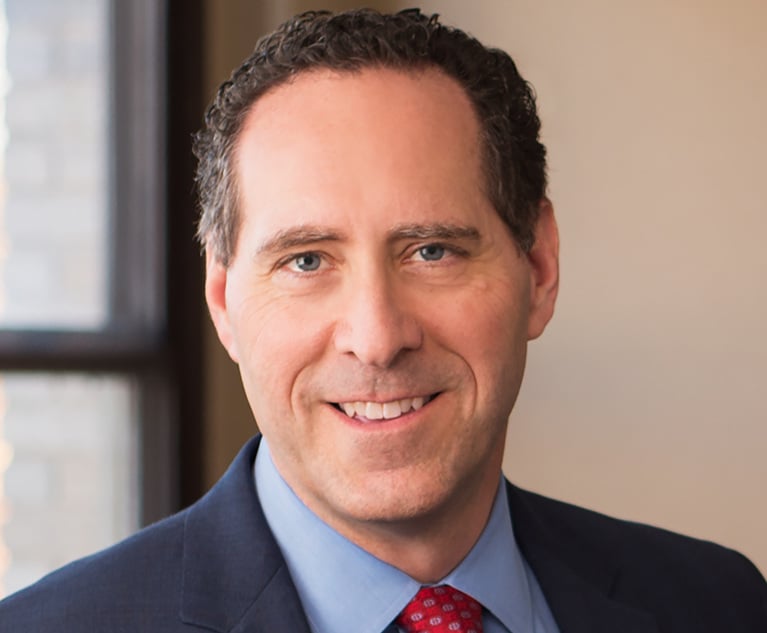The Six Habits of Highly Effective Law Firm Thought-Leadership Content
Your law firm's blog posts, bylined articles, and client alerts will connect better with their audiences if they always do these six things.
April 30, 2020 at 12:55 PM
9 minute read
 Wayne Pollock.
Wayne Pollock.
About eight weeks ago, I discussed four statistics from a recent study that should compel you and your law firm to go all in on creating thought-leadership marketing content, including blog posts, bylined articles and client alerts.
Just a week or two later, the COVID-19 pandemic forced schools and many businesses to close, "shelter in place" orders to be proclaimed, and each one of us to change virtually every aspect of our daily lives overnight.
As you probably could tell by what's been in your email inbox and on your social media feeds, the legal issues raised by the COVID-19 pandemic and governments' response to it prompted law firms to collectively create a cornucopia of thought-leadership content. In the wake of the COVID-19 pandemic, many law firms appear to have gone all in on thought leadership.
But that cornucopia has had its fair share of rotten apples.
In the rush to churn out timely thought-leadership content, many attorneys are spending nonbillable time creating lackluster content few prospects, clients or referral sources will take the time to consume. When this kind of content is ignored by its intended audiences, it cannot do its job of positioning its creators and contributors as go-to resources on the topics they're discussing.
(Nor does it provide a positive return on investment for attorney time that could have been spent on billable matters.)
The good news is that the thought-leadership content you and your law firm publish can easily avoid this same fate. It simply has to adopt these six habits developed by widely read, and highly readable, law firm thought-leadership content.
Habit No. 1: Employ Irresistible Headlines and Email Subject Lines
You've surely been on the receiving end of law firm thought-leadership content that has dull headlines and is distributed via emails with drab subject lines.
Those law firms fail to realize that headlines and email subject lines have a singular but monumental task: persuade the people on the other end of them to keep reading. They're the only things keeping those people from closing a web browser tab or deleting an email and ignoring those firms' thought-leadership content in the process.
Give your thought-leadership headlines and email subject lines the attention they deserve. Invest time in creating compelling ones that dare your audience to ignore your content. In the course of a dozen or so words, provide a takeaway, identify a pain point shared by the audience, or otherwise connect with them in a way that compels them to keep on reading.
Habit No. 2: Start With Strong Ledes
Law firm thought-leadership content often buries the lede, forcing prospects, clients and referral sources to make their way to the very end of that content before learning what they need to know about what's being discussed. But the longer they need to wait to hear the punchline, the less likely they'll be to stick around for it.
When creating thought-leadership content, work hard to ensure that consumers of that content don't have to. Make it clear as early as possible what they should take away from the discussion. Your ability to quickly and clearly communicate the upshot of your analysis of a complex legal issue will not be lost on them, as it bodes well for your ability to help them with their complex legal issues.
Habit No. 3: Add Abundant Value
There's a lot of attorney "thought-leadership" content out there that simply regurgitates what a court, legislature or administrative agency said, with perhaps a dollop of analysis in the form of a two-sentence conclusion.
(This has been particularly true with COVID-19-related thought-leadership content where law firms are racing to be among the first to publish commentary about a particular development.)
Regurgitation is not thought leadership. It provides no value to clients or referral sources. It does not give them actionable knowledge they can apply to their situations. Equally important, it does not help you differentiate yourself from colleagues and competitors who serve those same clients and referral sources.
You know what does? Thought-leadership content that answers these three questions:
- "What?" (The recent development);
- "So what?" (Why a prospect, client or referral source should care); and
- "Now what?" (What they should do moving forward as a result of the development).
If your thought-leadership content answers these three questions, it can't help but provide value to the people consuming it.
Habit 4: Structured to Maximize Readability
Your written thought-leadership content should be structured to be consumed with ease, and to hold the attention of its readers for its duration. Prospects, clients and referral sources are not going to devote significant time and mental energy to comprehending thought-leadership content. If a piece of content seems too dense for them, they'll move on from it quickly.
This means you should be using short paragraphs and sentences. The longer your sentences and paragraphs, the harder they'll be for your readers to digest.
Short sentences and paragraphs will create more white space in your content than you're used to. That's OK. White space will enhance your content's readability and give it a lighter, more appetizing feel.
You should also be using subheadings and smooth transitions from one paragraph to another. Both are vital to your readers understanding how your ideas or arguments logically fit together. If your readers can't follow your logic, or your content is raising questions in their minds that it's not answering, they won't be reading for much longer.
Habit 5: Speak in an Alluring Style
Thought-leadership content you've structured to be consumed with ease may still be given short shrift by its would-be consumers if you're not communicating in a style that entices them to keep on consuming.
I could give you a laundry list of "don'ts" here to help you create thought-leadership content in an alluring style, such as "don't use legalese," "don't speak in a stuffy and overly formal way," "don't employ weak verbs," "don't include unnecessary details," and "don't overuse the passive voice."
Instead, here's a "do" that covers these "don'ts" and more: when you are crafting thought-leadership content, imagine you're talking to a prospect, client or a referral source in an informal setting such as over a friendly meal. (Or, given when this column will be first published, a friendly meal shared remotely through a video chat).
When you have such conversations, you probably talk about complex topics in a casual but polished style that allows the person sitting across from you to easily understand what you're saying. Employ the same style in your thought-leadership content. You will make it easy for consumers of that content to digest it. They will look favorably upon it and you as a result—and they will keep coming back for more.
Habit No. 6: Speak to a Particular Audience
Avoid writing one-size-fits-all thought-leadership content. When you try to speak to everyone, you end up speaking to no one in particular.
Prospects, clients, and referral sources are like you and me: motivated by self-interest. They are drawn to content they feel is written specifically for people like them, standing in their shoes, seeing the world from their eyes. So give them what they want. Make your thought-leadership content all about them.
Create your content with specific prospects, clients, and referral sources in mind. These could be people you already know, or people with particular job titles that you would like to get to know. Speak to them in their language and in a way that shows them that you understand the legal, business, economic, and political opportunities and concerns the topic you're covering creates for them, their organizations, and their industries.
When you craft thought-leadership content targeted to specific audiences, those audiences will view you as more credible and capable than other attorneys covering the same topics at a general level because you spoke directly to them about what they may be dealing with.
Make It a Habit (or Six)
No matter your legal practice or the size of your law firm, thought-leadership marketing is a tried and true way to market to current and prospective clients and referral sources.
Most attorneys and law firms know this. But few are producing thought-leadership marketing content that clients and referral sources want to consume. Whatever the reason for this phenomenon—a lack of time, a lack of ability, or both—it provides you and your firm an opportunity you both should pounce on.
You can build and strengthen connections with current and prospective clients and referral sources, while standing out from your competition, by creating compelling thought-leadership marketing content.
Ensure your thought-leadership content develops the six habits I've described here, and you'll be well on your way to doing so.
Wayne Pollock, a former Am Law 50 senior litigation associate, is the founder of Copo Strategies, a legal services and communications firm, and the Law Firm Editorial Service, a ghostwriting service for attorneys and their law firms. The Law Firm Editorial Service creates attorney-written thought-leadership marketing content for attorneys so that they can market themselves while staying billable. Contact him at [email protected] or 215-454-2180.
This content has been archived. It is available through our partners, LexisNexis® and Bloomberg Law.
To view this content, please continue to their sites.
Not a Lexis Subscriber?
Subscribe Now
Not a Bloomberg Law Subscriber?
Subscribe Now
NOT FOR REPRINT
© 2025 ALM Global, LLC, All Rights Reserved. Request academic re-use from www.copyright.com. All other uses, submit a request to [email protected]. For more information visit Asset & Logo Licensing.
You Might Like
View All
Superior Court Directs Western Pa. Judge to Recuse From Case Over Business Ties to Defendant
3 minute read
Neighboring States Have Either Passed or Proposed Climate Superfund Laws—Is Pennsylvania Next?
7 minute read
Cohen Seglias Leader Discusses Growing From Construction Practice into Full-Service Law Firm
Trending Stories
- 1Silk Road Founder Ross Ulbricht Has New York Sentence Pardoned by Trump
- 2Settlement Allows Spouses of U.S. Citizens to Reopen Removal Proceedings
- 3CFPB Resolves Flurry of Enforcement Actions in Biden's Final Week
- 4Judge Orders SoCal Edison to Preserve Evidence Relating to Los Angeles Wildfires
- 5Legal Community Luminaries Honored at New York State Bar Association’s Annual Meeting
Who Got The Work
J. Brugh Lower of Gibbons has entered an appearance for industrial equipment supplier Devco Corporation in a pending trademark infringement lawsuit. The suit, accusing the defendant of selling knock-off Graco products, was filed Dec. 18 in New Jersey District Court by Rivkin Radler on behalf of Graco Inc. and Graco Minnesota. The case, assigned to U.S. District Judge Zahid N. Quraishi, is 3:24-cv-11294, Graco Inc. et al v. Devco Corporation.
Who Got The Work
Rebecca Maller-Stein and Kent A. Yalowitz of Arnold & Porter Kaye Scholer have entered their appearances for Hanaco Venture Capital and its executives, Lior Prosor and David Frankel, in a pending securities lawsuit. The action, filed on Dec. 24 in New York Southern District Court by Zell, Aron & Co. on behalf of Goldeneye Advisors, accuses the defendants of negligently and fraudulently managing the plaintiff's $1 million investment. The case, assigned to U.S. District Judge Vernon S. Broderick, is 1:24-cv-09918, Goldeneye Advisors, LLC v. Hanaco Venture Capital, Ltd. et al.
Who Got The Work
Attorneys from A&O Shearman has stepped in as defense counsel for Toronto-Dominion Bank and other defendants in a pending securities class action. The suit, filed Dec. 11 in New York Southern District Court by Bleichmar Fonti & Auld, accuses the defendants of concealing the bank's 'pervasive' deficiencies in regards to its compliance with the Bank Secrecy Act and the quality of its anti-money laundering controls. The case, assigned to U.S. District Judge Arun Subramanian, is 1:24-cv-09445, Gonzalez v. The Toronto-Dominion Bank et al.
Who Got The Work
Crown Castle International, a Pennsylvania company providing shared communications infrastructure, has turned to Luke D. Wolf of Gordon Rees Scully Mansukhani to fend off a pending breach-of-contract lawsuit. The court action, filed Nov. 25 in Michigan Eastern District Court by Hooper Hathaway PC on behalf of The Town Residences LLC, accuses Crown Castle of failing to transfer approximately $30,000 in utility payments from T-Mobile in breach of a roof-top lease and assignment agreement. The case, assigned to U.S. District Judge Susan K. Declercq, is 2:24-cv-13131, The Town Residences LLC v. T-Mobile US, Inc. et al.
Who Got The Work
Wilfred P. Coronato and Daniel M. Schwartz of McCarter & English have stepped in as defense counsel to Electrolux Home Products Inc. in a pending product liability lawsuit. The court action, filed Nov. 26 in New York Eastern District Court by Poulos Lopiccolo PC and Nagel Rice LLP on behalf of David Stern, alleges that the defendant's refrigerators’ drawers and shelving repeatedly break and fall apart within months after purchase. The case, assigned to U.S. District Judge Joan M. Azrack, is 2:24-cv-08204, Stern v. Electrolux Home Products, Inc.
Featured Firms
Law Offices of Gary Martin Hays & Associates, P.C.
(470) 294-1674
Law Offices of Mark E. Salomone
(857) 444-6468
Smith & Hassler
(713) 739-1250






